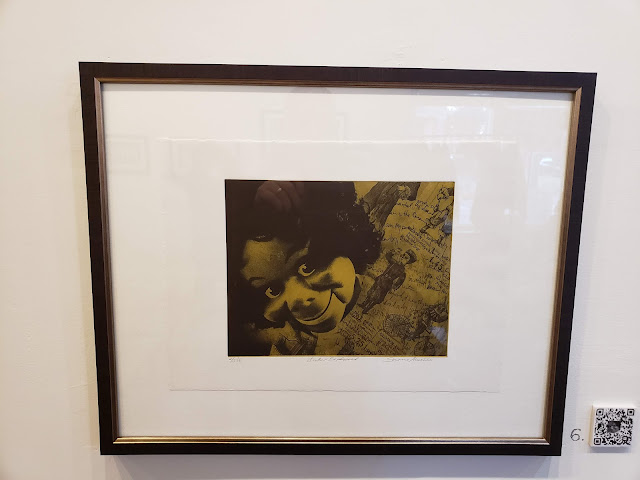In the last week, I saw two terrific exhibitions of work in and around Chicago.
The first was at a small but beautiful gallery space in Evanston. The work on display consisted of prints by Socorro Mucino and Janet Webber, who took one of my printmaking classes at the Lillstreet Art Center nearly two years ago. The title of the show, Paper Dolls, suggested a pun on the fact that these were works on paper depicting either a child's play-doll, or women as objects of desire (as in "hey, doll!").
Janet Webber's pieces were altered images of mannequins, ball gowns, and beauty queens, presented in rows or in combination with overprinted images and text. Very often the faces were obscured, and the image itself subjected to deterioration in the printmaking process, perhaps as a way of interfering with how these images of banal and old-fashioned female beauty would normally be seen by the male gaze.
Socorro Mucino's images of dolls struck me first as sweet and childlike, then very quickly sinister and unsettling. Like Webber's images, the dolls were often presented in rows, carefully arranged and then photographed to suggest narratives (the sentimental nostalgia of childhood, or the blank stares of the revivified dolls in horror films, maybe). QR codes fixed to the wall next to each photogravure print enabled visitors to call up a sound file, containing a story from the owner of the doll depicted in each print.
A few days later, I went to Orbit in Chicago to see a show by painter Dimitri Pavlotsky. Dimitri is a friend and also one of my favourite artists. I can't get enough of his whirlwind paintings, where line and colour and shape struggle together in the centre of the canvas until the materials and the artist slump back, exhausted after the fight and declaring a draw.
We had a long conversation, touching on the following topics: Dimitri's recent conversion to acrylic paints after working with oils for so long; the idea of struggle in making a painting; gesture, energy, Per Kirkeby's idea of the "final strike" to finish a painting; art training in a Soviet-era school; kinship with de Kooning and Bacon; daily drawing practice; selling work and professional development courses; art provoking an emotional response, whether it's painting, video, performance, or anything else.
Dimitri also has a great new website, which is worth checking out.
The first was at a small but beautiful gallery space in Evanston. The work on display consisted of prints by Socorro Mucino and Janet Webber, who took one of my printmaking classes at the Lillstreet Art Center nearly two years ago. The title of the show, Paper Dolls, suggested a pun on the fact that these were works on paper depicting either a child's play-doll, or women as objects of desire (as in "hey, doll!").
 |
| Janet Webber, paperlitho transfer and monoprint |
Socorro Mucino's images of dolls struck me first as sweet and childlike, then very quickly sinister and unsettling. Like Webber's images, the dolls were often presented in rows, carefully arranged and then photographed to suggest narratives (the sentimental nostalgia of childhood, or the blank stares of the revivified dolls in horror films, maybe). QR codes fixed to the wall next to each photogravure print enabled visitors to call up a sound file, containing a story from the owner of the doll depicted in each print.
 |
| Socorro Mucino, photograpvure |
We had a long conversation, touching on the following topics: Dimitri's recent conversion to acrylic paints after working with oils for so long; the idea of struggle in making a painting; gesture, energy, Per Kirkeby's idea of the "final strike" to finish a painting; art training in a Soviet-era school; kinship with de Kooning and Bacon; daily drawing practice; selling work and professional development courses; art provoking an emotional response, whether it's painting, video, performance, or anything else.
Dimitri also has a great new website, which is worth checking out.

